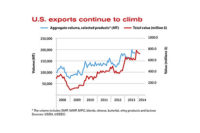
Can U.S. Dairy Companies Compete in a Globally
“Flattened” Market?
I just finished reading a wonderful book, “The World is Flat,” written by Thomas L. Friedman, a New York Times three-time Pulitzer Prize winner. He makes a compelling case that the fall of the Berlin Wall, the fall of the Soviet Empire and the end of the Cold War marked the end of the struggle between two opposing economic systems, capitalism and communism, unleashing the powerful forces of democracy and capitalism and allowing formerly economically struggling countries to become significant forces that “flattened the world.”
Friedman documents the role information technology has
played in the globalization and flattening of the world. This has freed
many countries to become major suppliers of goods and services throughout
the world, although their economies were previously centrally controlled,
performing poorly and largely dependent upon internal demand.
Great technological gains — especially in
information systems, real-time data and control mechanization of processes
and procedures — have made this possible. Friedman says it is the
“triple convergence of new players, on a new playing field,
developing new processes and habits for horizontal collaboration, that is
the most important force shaping global economies.”
I was inspired by Friedman’s challenging and
provocative ideas, because I think the U.S. dairy industry could be
propelled to greatness worldwide if we could open our minds to accept less
federally controlled planning — federal milk orders, price supports,
MILC program, subsidized exports (DEIP) — and more freedom to
innovate, create and compete.
Dairy farmers continue to develop milk production
capabilities that are competitive worldwide (maybe excluding New Zealand
and Australia, which because of their grass-fed milk production have
limited growth prospects). The U.S. dairy industry is very large, and
U.S. milk production exceeds all other countries. We are number one and
need to be proud leaders, as a number-one position requires.
U.S. processors’ and manufacturers’ costs
are very competitive with the rest of the world. The quality of U.S.
products is outstanding. So why has the U.S. dairy industry shackled itself
with a multi-layered government planning system?
Friedman builds a strong case for the stimulating
effects of competition to build and grow markets through innovation, and
the necessity to be creative and attentive to survive. He argues that
leveling the playing field through laws and regulations is the enemy of
growth and profitability.
Connie Tipton, president and chief executive officer
of the International Dairy Foods Association, has a vision to make the
United States the home of choice for companies that want to participate in
the growing worldwide market for dairy products.
She says, “Why not take advantage of our
favorable cost structure and know-how to make the United States the country
of choice for companies who want to compete globally?” Dairy farmers
would be the big winners as dairy products made with their milk are
consumed worldwide.
India and China may have advantages in outsourcing
information systems, but the United States has those advantages in dairy.
The U.S. should be the home for companies wanting to participate in
the world dairy market. The U.S. dairy industry deserves a vision of
aggressive growth and competition.
Why should the U.S. dairy industry settle for a
limited internal market when the world could be its oyster?
Let us know how you feel!
Tip Tipton, chairman and chief executive officer of
the Washington, D.C.-based Tipton Group, is the former CEO of the
International Dairy Foods Association.
Cheese Price Supports Up; FDA Sets Whey Standards
News from the May 1975 issue of Dairy & Ice
Cream Field.
The support price for
cheddar cheese produced on or after April 1, 1975, was increased 2 cents
per pound to 79.25. The support price for nonfat dry milk remains the same
at 60.6 cents.
The price of butter was increased 1.25 cents to 70.75
in New York. Beginning April 1 there will be only one designated market,
i.e. New York, and all other butter prices will be 70.75 less 80 percent of
the lowest published domestic railroad freight rate per pound gross weight
for a 60,000-pound carlot in effect April 1. However, beginning April 1,
1975, no price at any location shall be less than 67.75 cents per pound.
For example, the support price at Chicago will be
69.193, Chattanooga 68.573, Oklahoma City 68.399, Denver 68.055, Dallas
68.289 and Atlanta 68.581. West Coast areas would be no less than 67.75.
The probable use of whey solids in fortifying fluid
milk products has precipitated a memorandum to all regional food and drug
directors and regional milk consultants for whey products, according to a
bulletin from the Dairy and Food Industries Supply Association. FDA states
that in response to requests, “we have developed … criteria and
standards for sweet whey from cheddar cheese or any other cheese for use in
Grade A pasteurized milk and milk products.”
Samuel E. Dean, former chairman of Dean Foods Co.,
died March 12 at his home in Oak Brook, Ill. He was 67. Son of Sam E. Dean,
founder of Dean Milk Co., he took over after his father’s death in
1946, and as chairman of the company, later Dean Foods, he presided over
its diversification.
The Land O’Lakes dairy operation, including all
activities and plants handling milk and milk products, produced sales of
$697 million in 1974, a 16 percent increase over the previous year,
president Ralph Hofstad told the annual meeting. The dairy operation was
cited in the annual report as “an excellent example of the
cooperative’s ability to organize efficiently for the benefit of its
member owners.”
Forty-four men and women representing ice cream
manufacturers and supply companies from throughout the United States and
Mexico, Netherlands and Hong Kong attended the recent 83rd annual ice cream short
course held by the Pennsylvania State University. Following the trend of
recent years, many additional applicants had to be turned away because of
lack of space. Lectures, discussions and laboratory demonstrations were
concerned with the formulation and manufacture of ice cream, ice milk,
sherbet, water ice, artificially sweetened products, novelties and
mellorine.
$OMN_arttitle="Can U.S. Dairy Companies Compete in a Globally Flattened Market?";?>
